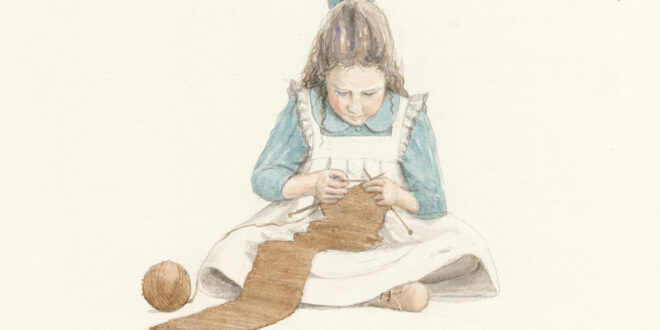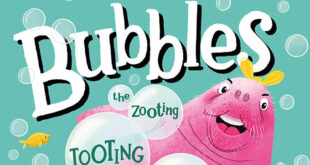By the author of Violet’s Scarf, Colleen Brown
I learned about Violet’s story when I was sitting in the Te Hikoi Museum Riverton Aparima watching a loop video of older Southland residents talking about their youth. Violet Craig (nee Cloughley) popped onto the screen, talking about being a child during WW1 and knitting a scarf to send to a soldier overseas. It was what happened to the scarf that utterly grabbed my attention. Violet told the story in such a matter-of-fact way, as if – ‘well that’s life.’
I remember sitting there by myself in the little theatre at the museum, with the hairs on the back of my neck standing up. I knew I had to write this story. At the time I was an elected Manukau City Councillor, and a member of the Counties Manukau DHB, and importantly, I’d never written a children’s book before. But the story stayed with me.
Skip forward fourteen years and my life is very different. I write for The Listener; I’ve written an adult book about the end of WW1 ’The Bulford Kiwi. The Kiwi we left behind.’; a children’s book ‘Elvie the Sheep’ so now it was time to write Violet’s Scarf.
All these books are true stories. All started with a personal connection. The Bulford Kiwi book started with a photograph of my great uncle Bertie Jarrett who served throughout WW1, and died in England in 1919 waiting for a ship to bring him home. His belongings came back to NZ but he lies in a grave in Tidworth Military Cemetery on Salisbury Plain. Elvie the Sheep is a true story about a sheep who lived in my aunts back yard in Kilbirnie Wellington. Illustrator Emma Lay and I worked together on this book during the Pandemic, not meeting each other until after the book was finished.
I collaborated again with Emma, to create, in Violet’s Scarf, a book to stir the heart of the reader, that would make children believe the power an act of kindness by a little girl can have on others. I wanted people to believe in the unbelievable.
It is a simple story. In 1915, Violet, aged eight, knits a scarf, parcels it up, and sent it via train and ship from the bottom of the South Island in New Zealand, first to Alexandria, intended for NZ troops at Gallipoli, then on to England and France. After a journey of around a year, Violet’s parcel gets loaded onto the back of the wagon and hauled out to a NZ camp, near the frontline in France. Two soldiers leap up on the wagon and toss the parcels out to the waiting troops. Violet’s brother George is among those troops. He jumps up, catches a parcel, reads the tag, opens it and it is Violet’s scarf.
We can only imagine what went on in George’s mind when this happened. George had a brutal, harsh war. He was a driver, taking goods up to the front line. He often brought wounded men back with him. A scarf from Violet must have seemed like a miracle to him. What was even more miraculous was that in 1916 when George caught the parcel, 250,000 Red Cross parcels were sent from New Zealand to our soldiers overseas. On top of this, the fact George was in camp that day was astonishing. He could have been anywhere along the line. For me, the story is all about serendipity; when sometimes in life, astonishing things just happen.
For two further years, after catching the scarf tossed in the air, George carried the scarf with him in his pack, along with the tag Violet wrote. He brought both home in 1918. The scarf unfortunately got destroyed in a fire, but the tag is safe in the Hocken Library in Dunedin. A truly exceptional story.
Emma’s illustrations are lush in New Zealand and bleak in France. They are full of many activities and things people would have known about at the turn of the century – feeding chickens, churning butter, milking by hand, walking to school along a beach, the big farmhouse kitchen. There is a familiarity to the illustrations, a feeling of ‘I’ve heard about this, or know about this.’ The parcel tied with red string is visible to the reader as it travels from Riverton to the frontline. The reader is connected to the passage of the scarf throughout the book.
For 108 years the Cloughley family have shared this story. Many Cloughley children learned to knit a scarf before they were eight years old – Violet’s story lives on. Now it can live on as part of New Zealand’s collective history.
I’m very passionate about telling our own stories. Often the stories are more than just a one-dimensional narrative. They are about us as a people. It connects us and informs us, links us to the past and can open our eyes to the future. Stories can remind us of who we are as a nation – what makes us Kiwis unique.
Many people have told me once they’ve read The Bulford Kiwi, they’ve looked again at letters their relatives sent from many different theatres of war, they’ve looked anew at old sepia photos, and wondered. I’ve had people call me – so excited they found their grandfather’s medals or a diary, or a postcard.
Sometimes our history isn’t as good as we’d like it to be. However, these are our stories and they deserve to be told, so we can learn from them and understand our past, going forward into our future.









BevT - 1 year ago
Loved the war stories.
My Mum served with the WAAFs in world War 2. She’d led a very sheltered life on a farm in Taranaki, so was quite a culture shock in the WAAFs. She got up one morning to find what she thought were deflated balloons outside the barracks. She’d never seen a condom before….let alone what they were for!!!